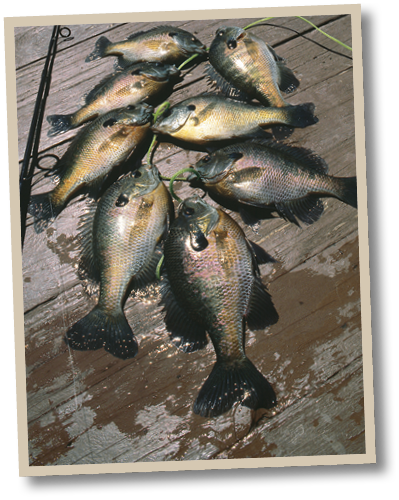Eating recreationally caught fish can be a healthy and tasty activity when you have the proper information. The following section should alleviate most anglers’ concerns about eating wild-caught fish.
It’s all about a person’s exposure to contaminants over time. The two contaminants that drive the fish consumption advisory are mercury and polychlorinated biphenyls (PCBs). Both contaminants are generally persistent in the environment at very low levels where they do not pose a health risk from direct contact with the water; however, both contaminants accumulate in fish tissue. The fish tissue contaminant amounts are not nearly high enough to make humans sick from just one meal or even several meals. If it was perceived that they were, there would be a ban on consuming fish, not just an advisory.
The risk of eating contaminated fish manifests itself over time. The contaminants accumulate in human tissue like they do in fish and can build to levels that could pose a health threat. The consumption advisory is based on a model that people are consuming 8 oz. of fish on 225 days each year over 70 years. A determination can then be made from concentrations of contaminants in fish tested as to how frequently they can be safely eaten (note the fish consumption advisory groups). Most anglers do not eat wild-caught fish nearly this frequently. As a result, if they are aware of the contaminant levels that likely are in the fish they catch, they should have little concern about eating them.
The primary concern is with the sensitive population. This population comprises women of childbearing years, nursing mothers and children under age 15. The reason for extra concern is evidence of developmental problems in babies and young children from contaminants at levels lower than what can be safely eaten by adults. The advisory reflects this concern. There is added concern about this group eating commercial sources of fish. Even though this group may not eat wild-caught fish alone frequently enough to be concerned, combining such consumption with frequently eaten fish from commercial sources containing contaminants could pose a health risk. Note the commercial fish consumption table for the at-risk group and for people that frequently consume commercial fish.
Eating fish from lakes and reservoirs is generally less of a concern. Contaminant levels are generally very low in lakes and reservoirs (note major group 1 and 2 fishing waters table). Also note the table containing all of the sampled lakes and reservoirs in Indiana that had species of fish in groups 4 and 5.
Eating fish from rivers and streams is generally a much higher concern. Most water bodies carrying do-not-eat consumption advisories for all species are streams. The fish consumption advisory has an extensive list of rivers and streams that have species with group 4 and 5 consumption advisories; however, many streams contain species with low levels of contaminants. Several of the major fished rivers that have some group 4 and 5 species are listed. Many of these rivers and streams contain some very good catch-and-release fisheries.
-
Guidelines To Reduce Your Risk
- Assume that any fish you catch is a group 2 if the site in which you caught it is not listedor the site where you are fishing is not listed in the advisory.
- Eat smaller, less fatty fish like panfish (bluegill, perch and crappie).
- Remove fat near the skin of the fish before cooking and broil, bake, or grill fish so the fat drips away.
- Unless noted otherwise, consider all carp from rivers and streams to fall under these groups: Group 3, 15-20 in.; Group 4, 20-25 in.; Group 5, over 25 in.
WILD FISH CONSUMPTIONADVISORY GROUPS Group General
PopulationSensitive
Population
Advisory*1 Unlimited
consumption1 meal per week 2 1 meal per week 1 meal per month 3 1 meal per month Do not eat 4 1 meal every
2 monthsDo not eat 5 Do not eat Do not eat *Women of childbearing years, nursing mothers,
and children under age 15.COMMERCIAL FISH CONSUMPTION ADVISORY Species General Population Sensitive Population
Advisory*Fresh or canned salmon; shellfish like shrimp, crab, and oysters; tilapia; sole; plaice; herring; canned “light” tuna; scallops; sardines; pollock; cod; catfish; flounder; farm-raised rainbow trout; haddock; and squid Unlimited consumption 1 meal per week Canned albacore “white” tuna (6 oz.), tuna steak, halibut, and lobster 1 meal per week 1 meal per month Shark, swordfish, tilefish, king mackerel, orange roughy, Spanish mackerel, marlin, grouper, bass (Chilean), walleye (Great Lakes, Canada) 1 meal per month Do not eat *Women of childbearing years, nursing mothers, and children under age 15. Contact the ISDH for more detailed information on the commercial fish consumption advisory.



















![The Best Deer Camp Chili [VIDEO] Deer Chili Ingredients, Tomatoes, Chili Spices](/wp-content/uploads/2015/10/Deer-Chili-Deer-Camp-Recipe-218x150.jpg)
![How to Call Elk Early in the Season [VIDEO]](/wp-content/uploads/2016/08/byers003-218x150.jpg)




![Idiots Disturb Hunter: How Would You Have Handled It? [VIDEO]](/wp-content/uploads/2015/10/DSC00110-e1474487693878-100x70.jpg)
![Albino Buck Shocked to Shed His Antlers [VIDEO]](/wp-content/uploads/2015/10/AlbinoDeer-100x70.jpg)